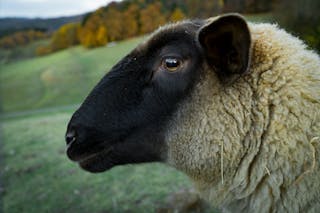
Tying up, also known as azoturia or ‘Monday Morning Disease’ (because of often first being noticed after a weekend), is one of the most common causes for equine lameness. It affects an estimated 5-10% of all horses, and can affect the horse's ability to move and even collapse in extreme cases.
So what exactly causes a horse to tie up? Unfortunately, there is not just one cause – tying up stems from different metabolic imbalances in the body which could be caused by any number of things. Diet is usually at the forefront of these and consists of too much carbohydrate/starches or plant proteins (such as alfalfa hay). Also linked with tying up are: electrolyte imbalance, exercise-associated rhabdomyolysis (ER), Neuromuscular Disorders (NMD) and intramuscular glycogen depletion.
Of those mentioned factors, diet plays the biggest role when it comes to tying up in horses. Diets that include too many starches like grains can cause an increase in muscle acidity leading to painful contractions, reduced oxygen uptake among red muscle fibers leading to lactic acid buildup as well as an overproduction/accumulation of harmful free-radicals throughout the body – all causing a horse to tie up. This means ensuring your horse's diet contains enough fibre or roughage while limiting grain intake will greatly reduce their chances on tying up due its low NonStructural Carbohydrate content - preventing blood sugar spikes associated with high NSC types diets such as oats and corn meal for example. Additionally reducing concentrate feeding if it has been taken off pastures giving them a chance for their digestive system reset itself should also be considered - reducing symptoms caused by rich starch diets whilst putting them back onto reliable roughage levels will help keep your horse safe from ties ups whilst promoting better overall health and wellbeing throughout management!
What is the most common cause of a horse tying up?
Tying up, also known as tying syndrome or azoturia, is a debilitating and frustrating condition for horse owners. It is characterized by a sudden occurrence of muscle pain, muscle stiffness and fatigue, typically affecting the hindquarters of the horse. While there are multiple causes for tying up in horses, the most common cause is exercise-related metabolic syndrome (ERS). In other words, ERS occurs when a horse has too-intense exercise which can lead to excessive muscular and energy demands.
The primary trigger for exercise-related metabolic syndrome is derived from overtraining or excessive exercizing leading to an extreme build up of lactic acid in the muscles. During overtraining lactic acid increases quickly in order to provision energy during physical exertion but cannot be processed efficiently by the body's systems due to exhaustion. As this build up continues it interferes with normal physiological processes within the animals' muscles causing discomfort and fatigue that can eventually lead to tying up.
There are several risk factors associated with ERS that may include breed predisposed weakness or abnormalities like shivers; improper nutrition; inadequate warm ups or cooling down after exercising; environmental factors associated with heat stress such as overexposure to direct sunlight during mid-day workouts; hormonal imbalances resulting from exhaustion/overstress during training regimes and dehydrationm etcetera.... All of these situations demand an elevated level of vigilance while managing at risk horses because improper training regimes may potentially damage their health leading directly into incidents of tying up in an effortless manner if not appropriately addressed..
What are the potential dangers of a horse tie-up?
People who own horses or work with them on a regular basis may be familiar with the concept of "tie-up," which is the tethering of a horse to a post or other structure. While tying up your horse can provide safety and convenience in certain situations, it isn't without its potential dangers. It's important to recognize these risks and take appropriate safeguards when it comes to tie-up.
One of the main risks associated with tying up horses is that they can become entangled in their tethers and potentially injure themselves in the process. This risk is particularly high if they are tied too close to objects like fences, trees, or other horses that can be snagged by the rope or chain used for tie-up. To mitigate this risk, you should always ensure your horse’s tether has plenty of slack so he has some freedom of movement but cannot get himself wrapped around anything dangerous.
Another potential danger connected to tie-up is physical damage due to overstretching or improper positioning resulting from immobility for an extended period of time. Horses bodies are delicate and tying them up often means suspending them awkwardly in one position for hours at a time - leaving strain where there should be none for such long periods increases the likelihood of sprains, pulls, and pulled muscles (among other injuries). Check on your tethered horse periodically throughout his stay - luckily this only takes seconds - but could make all difference in preventing injury through static immobility overreaching if needed!
Finally, if not managed appropriately and left unmonitored throughout their day out ties-up also come with possible escape attempts/risk which could cause injury/wounds during their escape as well as leaving room for predators an opportunity which could lead into further problems too! So again monitoring often attached animals while they're tied outside will help lower any risks related here; plus if an animal tries pulling away limit pressure on their leads allowing more individual slack rather than trying tug against tugging actions allowed by metal chains etc...
In summary; Despite all hazards posed there some great uses for leveraging 'ties-ups' appropriately: safer loading/shoeing sessions & resting times between hours outdoors; though learning how mitigate any involved potential dangers will ensure proper safety & wellbeing standards remain even when using ties-around methods mentioned here today!
How does a horse tie-up episode typically start?
A horse tie-up episode typically starts with some type of spasm or stiffness in a single muscle group. The affected muscle may be located around the shoulder, neck, or flank area of the horse. Common signs of a tie-up episode are sudden onset stiffness and sometimes reluctance to move. A horse with a tie-up episode will also exhibit elevated heart rate and respiration, as well as sweating and trembling. The initial stage may appear minor, with localized pain and the horse continuing to function normally; however, if left untreated the symptoms can progress quickly leading to life-threatening complications like paralysis or death.
The root cause of a tie-up episode is normally an imbalance in energy metabolism within muscle fibers resulting from inadequate rest periods between periods of intense activity. This causes strain on muscles that leads to microtears in tissues which then fail to repair themselves properly leading further down this path towards lactic acidosis (lactic accumulation). Inadequate nutrition can worsen this condition and often contribute to higher incidences of episodes in young horses who have not fully developed their muscular systems yet.
If you suspect your horse might have had a tie up episode it is important that they receive professional veterinary attention right away before any long term damage can occur due to lack of treatment. Treatment should include appropriate rest tailored for individual horses based on their levels of work stress as well as nutrition adjustments if needed; electrolyte supplements can also help combat severe dehydration during an eventful situation like this one since most horses tend to lose large amounts fluid due scientific imbalance taking place within their bodies during these events.
Are horses at risk of tie-up syndrome more commonly seen in certain breeds?
The simple answer is yes; horses at risk of tie-up syndrome are more commonly seen in certain breeds, such as quarter horses, draft horses, thoroughbreds and Warmblood breeds. Non-breeds can also be affected.
Tie-up Syndrome, or azoturia, is a metabolic disorder that occurs when muscle tissue becomes unable to use energy stored in the cells properly. This leads to fatigue, stiffness and cramping of the horse's muscles during exercise and even at rest. Horses are usually affected after exercise and can become uncomfortable very quickly if not treated.
It is thought that genetics play a role in increasing the likelihood a horse will suffer from tie-up syndrome as some breeds appear to be predisposed to developing this disorder more often than others. Quarter Horses have been shown to have a higher incidence of tie-up syndrome than other breeds while injuries such as overworking or too much concussion on hard surfaces can act as triggers for symptoms to present themselves suddenly or recurringly over time if underlying issues go unnoticed or untreated.
In addition to genetics some environmental contributors may take place such as changes in feed type or amount and changes from vigorous training programs which could contribute towards an increased risk for certain individuals with predisposition for tie-up syndrome development due particular genetic make up or occupational size/shape activities which do not favor tied individuals ie tall horses with long limbs competing in sprinted events then those shorter dogs on heavier feet involved with endurance sports where their long limbs can support an efficient running technique over extended distances day after day without requiring sudden explosive burst speed activities like those necessary during short sprinted events where speed reaches its max quicker but requires strain on reticulum acid buffers already existing within glycogen property laden muscles responsible for quick burst delivery of muscular strength required by these type performances wherein shorter dogs engage better thus reducing likelihood they develop tied up issues while performing Sprint events but still respond well when needing repeat performance longer days since body conformation doesn’t rely so heavily upon supporting weight unlike taller versions whom cannot support weight easily due lack limb length ability support mass above assigned gravity center increases risk overload event causes individual knots within provided fibers causing them blocked function fail rise need attention prevent coming end chosen activity being enjoyed experience hoped achieve outcome yield successful results from originally planned efforts put forth situation.
What are the nutritional recommendations for horses to help prevent them from tying up?
Having a horse that ties up, or "tying up syndrome," can be an incredibly frustrating experience for both the horse and owner. This condition is caused by increased lactic acid in the horse’s body due to excessive muscle activity, and it can lead to serious issues like spinal weakness, metabolic problems, heart muscle inflammation, and even chronic fatigue. As such, it is important to understand how proper nutrition can help your horse stay healthy by preventing them from tying up.
One of the most important nutritional recommendations is providing your horse with high quality hay or pasture that contains adequate amounts of long-stemmed fibers while minimizing sugars and starches. Long-stemmed fibers help stimulate saliva production in order to buffer stomach acids which directly helps protect against tying up syndrome. When feeding hay/pasture make sure there are no physical impurities like mould or foreign objects that could harm your horses health either physically or nutritionally.
Your horses feed should also provide them with the necessary vitamins and minerals they need on a daily basis - especially those related towards their energy needs such as thiamin (vitamin B1), magnesium, potassium and calcium. Pay particular attention to calcium as this will help maintain proper electrolyte balances within their bodies which serves as another direct safeguard against tying up syndrome as a declined pH level reduces oxygen uptake by muscles cells required for contractions/movement which may result in cramping. Furthermore implement drinking sources of clean water for ample hydration - this coupled with intense exercise allows for waste products such as lactic acid produced during muscle contractions too exit horses body more readily therefore thwarting potential ‘buildup’ from occurring resulting in tie-up episodes down the road.
Finally supplementing a diet containing high grain amounts with oil based feeds instead may be beneficial since fat molecules are able naturally produced less lactic acid than carbohydrates when being broken down along same time supplying noteworthy levels energy whilst not entirely ‘ uncomplicating ' dietary needs prior practiced regimens followed nonaffected horses A recent study conducted several researchers has revealed that adding flaxseed meal had therapeutic effects tiedown equine cases avoidingly meaning further benefits derived seem highly plausible (Blaxter et al., 2016) All these endeavors aiming monitor improve nutritional status bring forth tangible improvement terms avoiding occurrence itself obtainable when employ strategies indicated useful possible sense application context find fit particular situation while knowing anytime interventions made they done best interest benefit well-being own four legged companions way home
What are the signs to look out for that may indicate a horse is at risk of tying up?
Tying up, also known as azoturia or Monday morning disease, is a potentially life-threatening condition that can affect horses. Symptoms of tying up generally include muscles twitching, sweating, and showing signs of unwillingness to move. While the exact cause of tying up is still being researched, there are certain warning signs that horse owners should be aware of when suspecting their horse may be at risk of this dangerous condition.
One early sign that your horse may be at risk for tying up is if they are rapid panting and hyperventilating while exercising. This could indicate they are struggling to use oxygen efficiently and be a sign their muscles cannot absorb enough oxygen leading to buildup of lactic acid in the muscles which can lead to muscle injury or stiffness.
Also watch out for excessive muscle fatigue after exercise. If your horse’s body temperature appears higher than normal or takes longer than usual for them to cool down after being exercised it could mean they are more prone to developing tying up due to stress on their muscles from over-exertion while working too hard or too long in one session without any rest period in between activities.
Moreover if your horse is displaying resistance when trying to move forward such as having difficulty picking his feet off the ground or throwing his hind legs sideways it could mean he does not have sufficient energy stores available for muscular contraction resulting in cramping or stiffness during movement associated with tying up syndrome.
Additionally it’s important you pay attention even before exercise has taken place by monitoring your horses eating habits; if you suspect there has been a change such as decreased appetite leading into short workouts then this could also indicate an increased risk of Tie Up syndrome due to poorer nutrition which compromises muscle health before strenuous activity occurs no matter how short duration exercise will take place afterwards.
Finally track changes between workouts over time; if you notice deterioration where previous comfortable performances become difficult exercises you should schedule a vet visit right away as early intervention can help prevent more serious complications arising from this condition later down the road when left untreated so keep an eye out for these warning signs!



